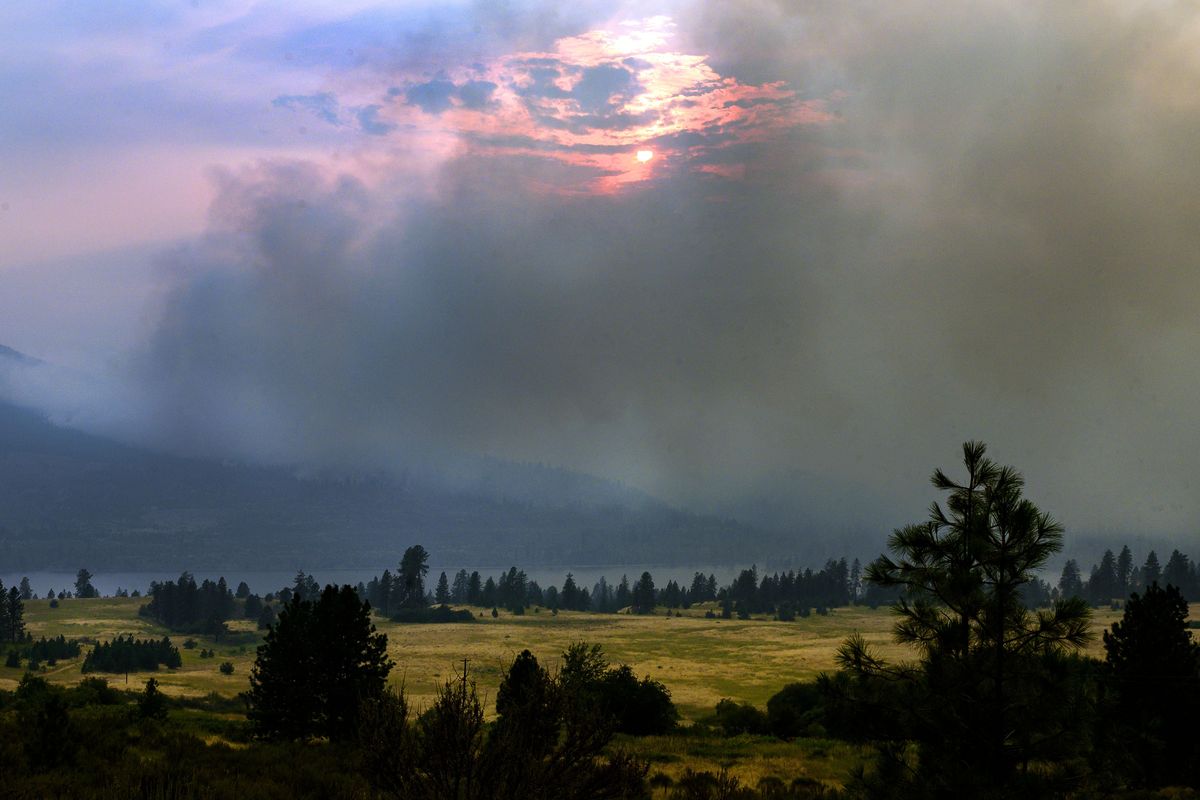Crews work to stop Colville Reservation fire from jumping the Columbia, prepare for the possibility it will

Fire crews worked through Wednesday night to keep the William Flats Fire on the Colville Indian Reservation from jumping the Columbia River at Lake Roosevelt and moving farther east toward the Spokane Indian Reservation.
Those efforts were successful as of late Thursday when more than 900 firefighters continued to battle the fire, but locals and officials remained concerned that the southeast flank of the fire would cross the Columbia and move toward the town of Hunters, where flakes of ash were falling Thursday evening.
“We understand the peoples’ fears, but we can’t say it’s not going to happen,” said Dana Leavitt, spokesman for the U.S. Fire Service incident type 3 management team.
As of 9 a.m. Thursday, the nearly 35,000-acre fire extended from the Whitestone Lookout down to the banks of the Columbia River and was only 25% contained. The containment was mainly in the southwest portion of the fire, where it started. It is largely not contained on the eastern front, where it has expanded.
Weather could be an important factor in what happens next. The forecast in the area shows temperatures dropping heading into the weekend and thunderstorms with increased precipitation.

“If the weather pattern does come as forecast, it would moderate fire behavior,” said Donna Storch, spokeswoman for the Northwest Interagency Incident Management Team 8. “That would allow crews to focus on containment.”
About the odds of the fire jumping the river, Fire District 2 Chief Rick Anderson said, “You’d have to get all the stars to align.”
However, crews are busy preparing for that possibility. The Department of Natural Resources team that Anderson manages is a local volunteer crew with members based in Hunters. They have worked with incoming crews from the National Parks Service, the Spokane Indian Reservation, surrounding fire districts and the Bureau of Land Management.
“We’ve done the best we can with planning,” Anderson said. “The interesting part is we all live here, so this stuff gets highly personal.”
Anderson and his crew recalled the 2015 Carpenter Fire, which had one fatality and multiple structures lost.
To combat resident’s fears of a similar situation, Anderson is focusing on community engagement.
“They’ve seen us out and about,” Anderson said. “We want people to know we’re prepared.”
With the fire crews and emergency management teams in the areas, Anderson said that officials have “a mini-task force over here.”
Fire crews were stationed Thursday morning on the east side of Lake Roosevelt, ready for airborne embers to possibly start fires on the Spokane Indian Reservation, where more than 125 buildings were under Level 1 evacuation notice, Anderson said.
Level 1 notice means people should be ready for potential evacuation.
Meanwhile, Spokane’s air quality was briefly ranked the worst in the nation Thursday morning, according to the Environmental Protection Agency.
Most of smoke was drifting south of the fire Thursday, said Jeff Cote, meteorologist at the National Weather Service in Spokane. But winds were forecast to bring some of the smoke east toward Spokane on Thursday evening before continuing north within the day or overnight.
Kathy Moses, spokeswoman for the Williams Flats Fire, said about 4 miles of shoreline on the west side of Lake Roosevelt were burned as of noon Thursday.
Officials issued new evacuation notices Thursday that affected more homes, according to a news release from Northwest Interagency Incident Management Team 8.
Spokesman Mark Turney said 11 homes are under Level 2 evacuation, which means people should be set to evacuate if ordered to do so, and 36 homes are under Level 3 evacuation, which means people should evacuate the area. All of the homes in the Level 2 and 3 evacuation zones sit to the west of Lake Roosevelt.
Firefighters worked overnight to protect multiple homes, according to the Thursday news release. Moses said the fire has not damaged any structures.
The National Parks Service closed Camp Na-Bor-Lee, located east of Lake Roosevelt in an area where the fire could jump the river, said Anderson.
The Spokane Indian Reservation closed all roads on the reservation between Lake Roosevelt and State Route 25 Thursday evening.
Mike Tedesco, executive director of the Spokane Indian Reservation, said the closures do not affect any occupied residences.
“The purpose is to limit spectators from gathering,” he said. “We feel that would not be safe.”
No roads north of the reservation were closed and state Route 25 was open as of Thursday, said Stevens County Sheriff’s Office spokesman Rick Anderson.
Camping and boating on the shore of the lake along the reservation was also restricted, according to a news release from the Spokane Indian Reservation.
Red Flag Warning for lightning
Due to expected lightning storms, near triple-digit temperatures and gusty winds, the National Weather Service issued Red Flag Warnings for much of Eastern Washington, including the Williams Flats Fire area and Spokane. The warning lasts through 3 p.m. Saturday.
“We’re concerned about the weather change,” Anderson said. “The Red Flag warning for lightning brings a whole new dimension.”
However, those lightning storms are likely to bring rain and possibly flash flooding as soon as Thursday night, according to the weather service.
Winds have carried the smoke into Spokane, causing poor air quality for much of the week. While the air quality was rated “moderate” for many people on Thursday afternoon, it was expected to worsen and become “unhealthy” later Thursday and into Friday, according to the Spokane Regional Clean Air Agency.